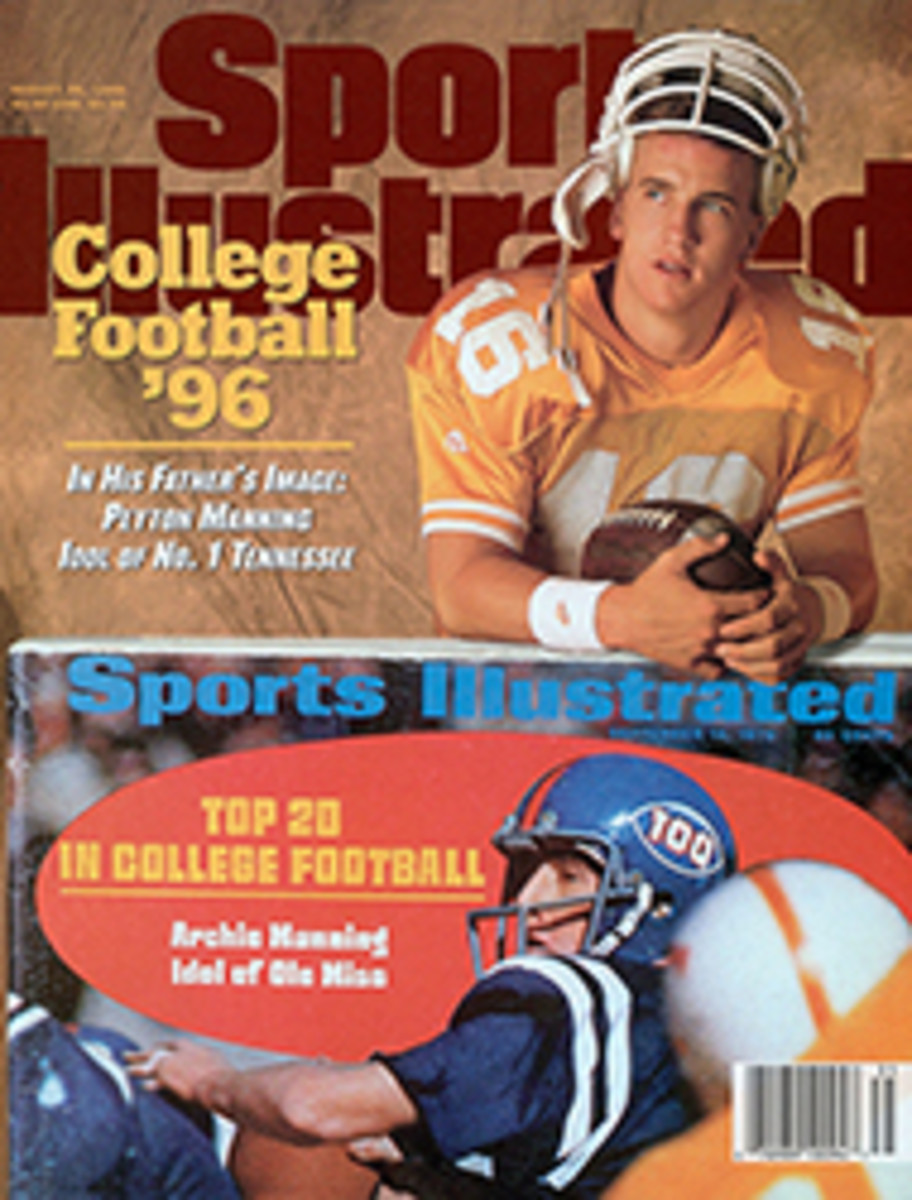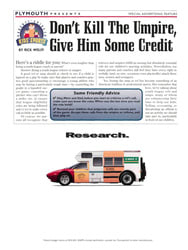
LOST GLORY OBERLIN IS JOHN HEISMAN'S ALMA MATER AND A FABLED CONQUEROR OF OHIO STATE, BUT THE YEOMEN HAVE HAD LITTLE TO CELEBRATE LATELY
They were, with apologies to Chuck Bednarik, the last of the
60-minute men. Of the 19 students who suited up for Oberlin's
season finale two years ago, only quarterback James Parker had
not played on both sides of the ball that fall. "We did it all,"
says center-defensive lineman Chris Lavin, who was a freshman
then. "Offense, defense, special teams, some guys playing every
down."
Of course, little glory is conferred upon any player, even a
two-way player, who suits up for a team that is outscored 358-10
and fails to score a touchdown on offense, as was the case with
Oberlin in 1994. Indeed, having to play both ways under such
circumstances seems less an honor than a sentence. "I remember
the 83-0 loss to Allegheny," says Adam Shoemaker, who played
free safety, tight end and fullback for the Yeomen in '94 and
who graduated last spring. "I'd look at the Allegheny sideline
and see players stretched from one end zone to the other. Must
have been 100 of them. Then I'd look at our sideline, where
there were more people out of uniform than in uniform."
Oberlin players no longer have to play the whole game , but that
doesn't mean the Yeomen's fortunes have improved. Last fall they
were outscored 469-72 and finished 0-10, extending their losing
streak to 30. Only Division I-AA Prairie View A&M, which has
lost an NCAA-record 57 consecutive games, has a longer streak.
Haplessness was not always the case at Oberlin, which, like
Prairie View, boasts a rich football history. John Heisman was a
player-coach for the Yeomen in 1892 and coached the team two
years later. Oberlin was the last Ohio school to defeat
powerhouse Ohio State, doing so in 1921 by the score of 7-6. "If
you go back, you'll find that football occupies a special place
at Oberlin," says third-year coach Pete Peterson. "As for
people's suggestions that we would be better off without
football, that's crazy. Absolutely crazy."
Yet against the backdrop of its recent history, the notion that
there was a Golden Age of Oberlin football seems impossible. On
the 2,800-student campus today, the game is viewed by some as an
underground activity. The school has other things to recommend
it, of course. Oberlin has been admitting women since it was
founded in 1833. Two years later the school opened its doors to
African-American students, becoming the first college in the
U.S. to admit both women and blacks. Oberlin is also famed for
its music program, which turns out world-renowned sopranos and
tenors with the same regularity that Penn State mints NFL
linebackers. "Oberlin doesn't get its identity from football,"
says history major Lavin. "I think there are some people on
campus who still don't know we have a team."
You can hardly blame folks for pleading ignorance. Oberlin
football has been so frightful in the 1990s, during which the
team's record is 2-56, that the Yeomen have actually kept the
clock running at home games when time should have been out.
Although Peterson denies this has happened on his watch,
athletic director Don Hunsinger admits, "A few years back,
before Pete got here, there was, yes, some, uh, clock management."
If only that were the worst of it. In 1992, after a 56-0 loss to
Allegheny, injuries and attrition had reduced the roster to 16,
forcing Oberlin to forfeit its subsequent game against
Wittenberg. There was some perverse solace to be taken from the
forfeit, though. "Nobody got hurt," says one school official,
"and a forfeit shows up as a 6-0 loss in the books, which was
better than most of our scores."
Peterson took over the Yeomen in June 1994. With the roster
nearly depleted and only two months to recruit new bodies, he
sent a letter to every incoming and returning male student. "I
don't remember exactly what it said," Peterson says. "Something
like, 'If you've ever dreamed of playing college football, we'd
like to have you come out.' We just didn't have time to recruit
the conventional way. If that meant taking a guy who had never
played football before, that's what we did."
Shoemaker was among the handful of Walter Mittys who took
Peterson up on his offer. He had played on the tennis and soccer
teams at Oberlin, and in the spring of 1994 several of his
friends suggested he give football a try, although he had never
played the sport in an organized league. Shoemaker broached the
subject with Hunsinger, who at the time doubled as the tennis
coach and the football team's defensive coordinator. Initially
Hunsinger dismissed the query as a joke. "Gradually, though, he
took me more seriously," recalls Shoemaker. "By the end of the
semester he came up to me and said, 'I think you'd make a pretty
good football player. Maybe you should give it a try.' He was
impressed by my attacking style, the way I'd do anything to get
to a ball, like running into the net or into the curtain that
surrounded the indoor courts. I thought about it during the
summer; then the letter came [from Peterson], and I decided to
go through with football."
Throughout the 0-9 season of '94, Peterson never had more than
24 active players. After the second week of preseason workouts,
no contact was allowed in practice. When players were excused
for lab classes, exams and injuries, coaches participated in
drills. It wasn't uncommon to see Hunsinger faking a handoff to
Peterson in the backfield and then firing the ball downfield to
defensive line coach Thomas Smith. Once, an out-of-town reporter
was called upon to serve as a defensive back. Given those
circumstances it comes as little surprise that the Yeomen's
second-leading tackler that fall was none other than the 6'3",
190-pound Shoemaker.
The 44-year-old Peterson laughs grimly at these anecdotes. He is
seated in a comfortable leather chair in the school's Heisman
Room, which was donated by the school's Heisman Club in 1978.
Above him hangs an elegant, four-foot-tall portrait of Heisman
himself, his carriage slightly bent, a ball tucked under his
right arm, his left arm thrust outward. It is the most
recognizable pose in college football. Yet, even with a guardian
angel like the great John Heisman watching over the program,
Oberlin has had little success signing the players it has tried
to recruit. In the last two years Peterson has sent letters to
more than 20,000 prospects. But this year he will probably open
the season with no more than 35 players. That is well short of
the 79 with which most Division III teams play.
Peterson sees progress, though. He speaks of Tom Hosier, who
hired him as an assistant at Eureka (Ill.) College 18 years ago.
In 1979 Hosier left for Macalester College in St. Paul, which
was in the midst of a losing streak that would run to 50 games,
the NCAA record until Prairie View eclipsed it last season.
"Within three years Macalester won four games in a season," says
Peterson. "Two years later they had a winning record. There's no
reason that can't happen at Oberlin. And don't forget
Northwestern, the program that gives all of us hope."
Oberlin has committed almost $400,000 to upgrading its football
facilities. Unlike her immediate predecessors, president Nancy
S. Dye is an avid supporter of the football program. And
Peterson's past two recruiting classes, though smaller than he
would have liked, have included some talented prospects. As a
freshman last year, Felix Brooks-Church, a lithe 6'4", 195-pound
wide receiver, caught 26 passes for 315 yards. This year's
freshman class includes 6'7", 305-pound offensive lineman James
Fielder, who was recruited as a walk-on by Arizona.
Oberlin players and coaches are optimistic. Church and Lavin
talk boldly of ending the streak and of making a run at a .500
season. "Oberlin gives you a great education," says
Brooks-Church, "but I came here to play football and win
football games too. We want to win as much as every other
college player. Unfortunately, until we win a game, the stigma
will be with us."
B/W PHOTO: OBERLIN COLLEGE ARCHIVES[Oberlin College football team in game]
COLOR PHOTO: DAVID LIAM KYLE Peterson knows who's looking over his shoulder, but Heisman can't help him break a losing streak that has reached 30. [Pete Peterson in front of painting of John Heisman]

